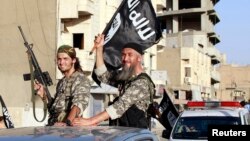The group calling itself “The Islamic State” continues its drive to conquer and rule a piece of the Middle East. Its violent campaign to spread its extreme form of Islam challenges the governments of both Iraq and Iraqi Kurdistan. A massive relief crisis is ongoing as hundreds of thousands of people flee its wave of terror and murder.
Radicals from all over the world are joining the Islamic State, driven by their shared desire to impose a radical brand of Islam in every land they conquer and create a ‘Caliphate” - an Islamic religious governing authority.
“The aim [of those supporting the Islamic State] is not power,” said Middle East analyst Tawfik Hamid of the Potomac Institute. “Their aim is to use power to achieve an ideological belief [the Caliphate]. The difference is huge – in the former case, they would sacrifice their ideology if this would help them gain power.”
But with the Islamic State, the opposite is true.
“They are not ready to make ideological concessions to reach power,” said Hamid.
The “Islamic State” was proclaimed in June. It asserted a Caliphate ruled the Syrian and Iraqi territory the militant group holds. And military operations continue to seek additional territory.
The Islamic State was formerly called ISIL – “The Islamic State of Iraq and the Levant” – the name it took in April, 2013. That, itself, is an outgrowth of what was called al-Qaida in Iraq, or AQI, which came together in 2006. The proclaimed head of the Islamic State, whose nom de guerre is Abu Bakr al-Baghdadi, became the leader of AQI in May 2010, and then ISIL.
In 2013 al-Baghdadi moved operations to take part in the rebellion against the regime of Syrian President Bashar Assad. He had a falling out with the Syrian Sunni radical group Jabhat al-Nusra – the Nusra Front, and the rift caused al-Qaida leader Ayman Zawahiri to disown ISIL and al-Baghdadi. But in June 2014, reports say al-Nusra agreed to send its fighters to join the Islamic State, giving its thrust into Iraq even greater energy.
Many intelligence estimates have pegged al-Baghdadi’s force at some 15,000. If al-Nusra, which has a similar force strength, has indeed merged there could be 30,000 fighters under the Islamic State’s black banner.
“The fighters are very heavily Iraqi/Syrian,” said Raffaello Pantucci at the Royal United Services Institute in London. “There are substantial bodies of people from across the world. The biggest community is from the Gulf [Saudi, Kuwait], but there is also a big group from North Africa [Tunisia and Libya seem very well represented]. Then from across Europe, a smaller number of North Americans, and then random clusters of Central Asians, Southeast Asians, Australians, and a few from Africa.”
The Islamic State, like al-Qaeda and other radical Islamists, use the Internet as a recruiting tool and a means of projecting terror.
“Their multimedia campaign is very slick and quite well controlled.They are active on social media, produce high quality videos with clear and easy messages,” Pantucci said. “Their videos and messages are clearly well received, as people re-tweet them and consume them with great vigor. The terror and violence they deploy in this direction is something of a trademark that obviously their followers enjoy and find appealing.”
The Islamic State posts videos to show its prowess on the battlefield. It is also uploading scenes of opponents getting shot dead and other forms of execution, including crucifixion.
Violence is a highly valuable tool to the Islamic State because it achieves the goal of control without any compromises to the group’s ideology. Much of that violence has been facilitated by the capture of weapons abandoned by the Iraqi army in Mosul and other cities, and with weapons brought into Iraq from Syria.
The Wall Street Journal quoted Center for Strategic and International Studies analyst Anthony Cordesman as saying “You lost approximately three divisions worth of equipment and probably at least three depots in that area [Mosul].”
Much of the equipment taken by the Islamic State when the Iraqi army fled Mosul was front-line American weaponry. Multiple reports say the loot included U.S. Stinger surface-to-air missiles, artillery pieces, Humvees, and heavy trucks, not to mention piles of assault rifles and ammunition. Because of this, the United States recently accelerated transfers of weaponry to the Kurdistan Government’s Peshmerga military, and initiated air operations in support of Peshmerga and Iraqi army movements.
While many call for robust military operations to crush the Islamic State, there must be a political solution, said RAND analyst and author Colin Clarke.
“Make progress on stabilizing Syria” and resolve its civil war”, he said. “Iraq desperately needs new leadership that is perceived by the Iraqi population as inclusive of all minorities.”
Clarke blames outgoing Iraqi Prime Minister Nouri Al-Maliki’s Shi’a “sectarianism [that] is in large part responsible for the popular support Sunnis now offer the Islamic State.”
A new Iraqi government – with a new prime minister and president – must move quickly and take decisive actions both militarily and politically to address the Islamic State.









